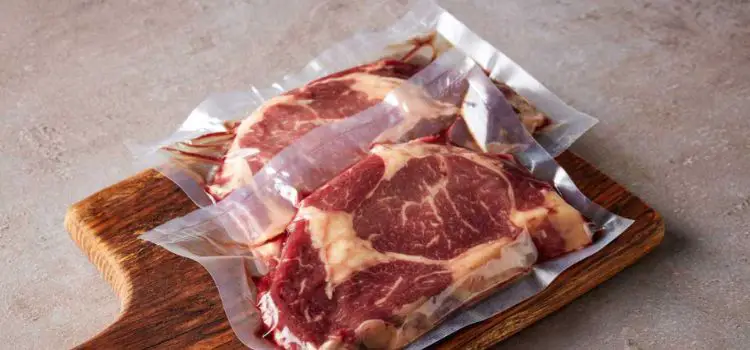As an Amazon Associate, I earn from qualifying purchases

Defrosting meat is a common kitchen task that can significantly impact the quality and safety of your meals. With various methods available, choosing the right one can be a bit daunting. Proper defrosting is crucial to ensure that meat is safe to eat and retains its flavor and texture.
Among the many methods, using a microwave is a popular choice due to its speed and convenience. This article explores whether you can defrost vacuum-sealed meat in a microwave, examining the process, safety considerations, and alternative methods.
How Microwaving Works for Defrosting
Microwaves are a staple in modern kitchens, known for their ability to quickly heat and defrost food. They work by emitting microwave radiation, which excites water molecules in the food, generating heat. Most microwaves come with a defrost setting, which operates at a lower power level to gently thaw food without cooking it. This setting is designed to prevent the outer layers from cooking while the inside remains frozen.
Using a microwave for defrosting offers several benefits, including speed and convenience. It allows you to defrost meat in minutes, making it ideal for last-minute meal preparations. However, there are drawbacks to consider. Microwaves can sometimes defrost unevenly, leading to partially cooked edges and a frozen center. This uneven defrosting can affect the texture and safety of the meat.
Safety Considerations
When defrosting meat in a microwave, safety is paramount. One of the main risks is uneven defrosting, which can create pockets of warmth where bacteria can thrive. To minimize this risk, it’s essential to monitor the temperature of the meat and ensure it doesn’t enter the “danger zone” (40°F to 140°F), where bacteria multiply rapidly.
Another safety consideration is the vacuum seal itself. Vacuum-sealed bags are not always microwave-safe, and heating them can release harmful chemicals or cause the bag to melt. It’s crucial to remove the meat from the vacuum-sealed bag before microwaving to avoid these risks.
Step-by-Step Guide to Defrosting Vacuum-Sealed Meat in a Microwave

Defrosting vacuum-sealed meat in a microwave requires careful attention to detail. Here’s a step-by-step guide to help you do it safely and effectively:
- Preparation: Removing the Vacuum Seal : Begin by removing the meat from the vacuum-sealed bag. Place it on a microwave-safe plate or dish to ensure even defrosting and prevent any potential contamination from the bag.
- Using the Correct Microwave Settings : Set your microwave to the defrost setting. If your microwave doesn’t have a defrost option, use a low power setting (around 30% power) to gently thaw the meat.
- Tips for Ensuring Even Defrosting : To promote even defrosting, pause the microwave halfway through the process and flip the meat. This helps distribute the heat more evenly and prevents the edges from cooking.
- Checking for Complete Defrosting : After defrosting, check the meat to ensure it’s completely thawed. The meat should be pliable and free of ice crystals. If it’s still partially frozen, continue defrosting in short intervals, checking frequently.
Alternative Defrosting Methods
While microwaving is convenient, there are alternative methods that may better suit your needs:
- Refrigeration Defrosting : This method involves placing the meat in the refrigerator and allowing it to thaw slowly over several hours or overnight. It’s the safest method, as it keeps the meat at a consistent, safe temperature.
- Cold Water Bath Technique : Submerge the vacuum-sealed meat in a bowl of cold water, changing the water every 30 minutes. This method is faster than refrigeration and safer than microwaving, as it prevents the meat from entering the danger zone.
- Comparison of Methods in Terms of Safety and Time : Refrigeration is the safest but slowest method, ideal for planned meals. The cold water bath is faster and safe, suitable for same-day defrosting. Microwaving is the quickest but requires careful monitoring to ensure safety.
Conclusion
In conclusion, while you can defrost vacuum-sealed meat in a microwave, it’s essential to follow safety guidelines to prevent uneven defrosting and potential bacterial growth. Removing the vacuum seal and using the correct microwave settings are crucial steps in the process. However, depending on your needs and circumstances, alternative methods like refrigeration or a cold water bath may offer safer and more reliable results.
By understanding the pros and cons of each method, you can choose the best defrosting technique to ensure your meals are both delicious and safe.
FAQ
How do you defrost vacuum sealed meat?
To defrost vacuum sealed meat, remove it from the bag and use one of these methods: place it in the refrigerator overnight for a safe, gradual thaw; submerge it in cold water, changing the water every 30 minutes; or use a microwave on the defrost setting, checking frequently.
Can you microwave vacuum sealed meat?
It’s not recommended to microwave meat in a vacuum sealed bag as it may not be microwave-safe, risking melting or chemical release. Instead, remove the meat from the bag, place it on a microwave-safe dish, and use the defrost setting for safe thawing.
Why shouldn’t you defrost meat in the microwave?
Defrosting meat in the microwave can lead to uneven thawing, resulting in partially cooked edges while the inside remains frozen. This unevenness can create warm spots that promote bacterial growth, affecting both safety and texture. Opt for more consistent methods like refrigeration or cold water baths when possible.
As an Amazon Associate, I earn from qualifying purchases